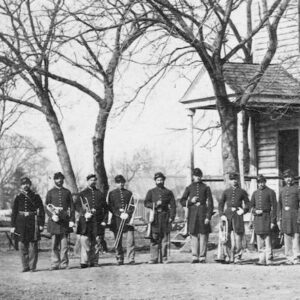Tag: 4th US Infantry (Band)
Wikipedia says: The U.S. 4th Infantry Regiment (“Warriors”) is an infantry regiment in the United States Army. It has served the United States for approximately two hundred years.
…In 1861 with the secession of a number of Southern states to form the new Confederate States of America, the regiment moved from its dispersed posts in the Department of the Pacific to Southern California to suppress any secessionist uprising. Charged with the supervision of Los Angeles, San Bernardino, San Diego, and Santa Barbara Counties, on 14 August 1861, Major William Scott Ketchum made a rapid march on 26 August and encamped near San Bernardino, California, with Companies D and G, later reinforced at the beginning of September by a detachment of ninety First U.S. Dragoons and a howitzer. Except for frequent sniping at his camp, this move stifled a secessionist uprising and prevented secessionist political demonstrations during the September California gubernatorial elections in San Bernardino County.
In late October 1861 the regiment was relieved by California Volunteer units and marched to San Pedro harbor where they waited for the balance of the regiment to gather before being transported to Washington D.C. to become part of the garrison in defense of the capital. The regiment was organized with other Regular Army units in the Volunteer Army as the First Brigade of George Sykes’s “Regular Division” of the V Corps. The regiment’s first Civil War engagement was in April and May 1862 during the Siege of Yorktown. By quick action at the Battle of Gaines Mill in June 1862, the Regulars saved Wood’s and Tidball’s artillery batteries from capture by Confederate infantry.
It participated as a part of the Army of the Potomac in the Second Battle of Bull Run and then the subsequent Maryland Campaign. At the Battle of Antietam, the regulars held the Middle Bridge over Antietam Creek, guarding the vital passage. They advanced towards the Confederate-held town of Sharpsburg, Maryland, late in the afternoon of 17 September 1862, before being recalled to their lines.
After seeing limited action at the Battle of Fredericksburg in December 1862, the regiment went into winter camp and saw no further combat for months. It formed part of Joseph Hooker’s rear guard at Chancellorsville. Throughout the Gettysburg Campaign, the regiment served in the Regular Division under its newly promoted commander, Romeyn B. Ayres. During the Battle of Gettysburg, it was part of the fighting on the Second Day, helping push back Confederate infantry near Devil’s Den and the Wheatfield.
Heavily depleted by battle casualties, the much-reduced regiment nevertheless continued to participate in the major campaigns of the Army of the Potomac, by 1864 under the command of Ulysses S. Grant during the Overland Campaign. The remaining men participated in the battles of Wilderness, Spotsylvania Court House, Cold Harbor, and the Siege of Petersburg. By the time the regiment manned the breastworks around Petersburg, a lieutenant, George Randall, was in command as the senior officer still present for duty.
On 22 June 1864, with less than 150 men left, the 4th Infantry reported to City Point, Virginia, to become Gen. Ulysses S. Grant’s headquarters guard. The greatly reduced regiment was present at Appomattox Courthouse for Robert E. Lee’s surrender. Grant, then commanding the armies of the Union, never forgot the 4th Infantry, with which he had served as a lieutenant in Mexico and on the frontier. As recognition of its valor during the Civil War, he designated it as the guard unit during the formal surrender ceremony.
Survivors of the 4th U.S. Infantry marched in the grand review of troops in Washington D.C. in May 1865, immediately following the war.
Showing the single result
